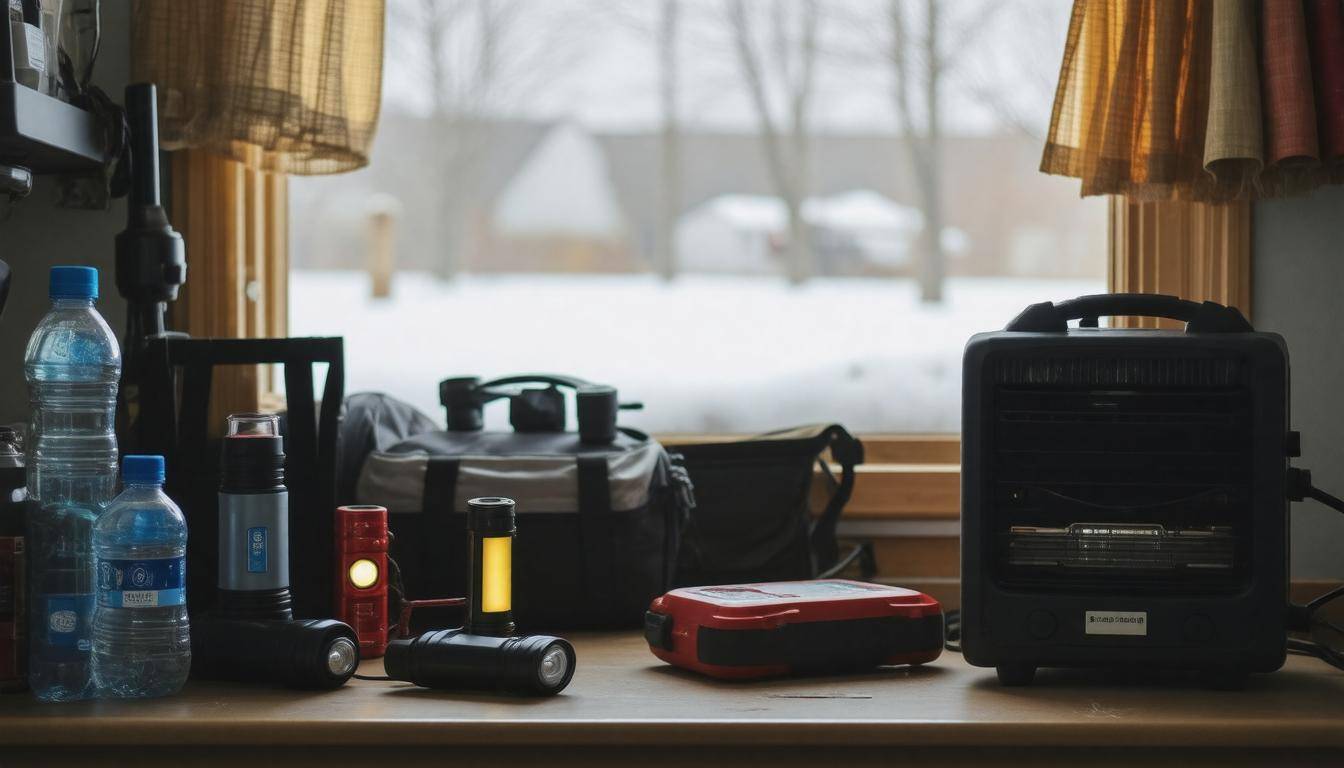As winter approaches, many people start to think about the joys of snowball fights and cozy evenings by the fire. But lurking beneath that cheerful facade is something far less pleasant: ice storms can strike without warning, bringing power outages and making life difficult. To help you navigate these potentially dangerous situations, we’ve put together a thorough guide to prepare for ice storm power outages. From understanding weather updates to gathering emergency supplies, each step is designed to keep you and your loved ones safe and warm during those chilly nights when Mother Nature decides to unleash her fury. Let’s dive into the essential steps to get ready before the winter weather hits!
The Ice Storm Power Outage Plan includes safety guidelines, emergency kit essentials, home insulation tips, and communication strategies to effectively prepare for and respond to power outages caused by ice storms. This comprehensive guide helps ensure that individuals and families can maintain safety, warmth, and access to necessary resources during severe winter weather events.

Assessing the Ice Storm Threat
Ice storms, often appearing deceptively beautiful when viewed from a distance, can unleash immense chaos in a matter of hours. They begin with freezing rain that coats everything in thick layers of ice, causing power lines to sag and trees to bow under the weight. Understanding how to accurately assess the severity of an impending ice storm will empower you to take proactive steps towards preparedness.
Monitoring Weather Updates
The first step in assessing the threat posed by an ice storm is staying informed about current weather conditions. Regularly checking local weather stations or utilizing apps on your smartphone can make a significant difference. These tools provide timely alerts and forecasts tailored to your location. One recommended resource is the NOAA Weather Radio, which broadcasts continuous weather information directly from the National Oceanic and Atmospheric Administration. Having access to real-time updates means you can receive urgent notifications regarding changing conditions.
Understanding the severity of an ice storm isn’t just useful—it’s critical.
Recent statistics show that areas experiencing more than half an inch of ice accumulation face heightened risks for prolonged power outages and severe property damage. With each additional inch of ice weighing down trees and power lines, the potential for outages escalates dramatically. That’s why keeping a close watch on these forecasts is vital; they can mean the difference between being prepared and facing an unexpected emergency without any supplies or plans.
It’s not just about knowing when a storm arrives, but understanding its potential impact. Recognizing terms like “Ice Storm Watch,” which indicates that conditions are favorable for an ice storm, or “Ice Storm Warning,” signaling that such a storm is imminent, allows you to tailor your preparedness efforts accordingly. Creating a checklist based on these warnings can help you strategize effectively—whether it means stocking up on food and water supplies or making arrangements for alternate heating sources right away.
Being vigilant about monitoring the potential impacts of an ice storm ultimately leads to informed decision-making, allowing you to prepare adequately for what may come. Having grasped the significance of weather updates and warnings, your next focus should be on gathering essential items that will ensure safety during an outage.
Compiling Your Emergency Kit
A comprehensive emergency kit tailored specifically for ice storms can make the difference between enduring a power outage safely and facing significant hardships. To start, think about what you’ll need for at least three days without power, since ice storms can disrupt services for prolonged periods. The first step is to gather essential items that will keep you warm, fed, and informed.
Essential Items
Begin with the basics like non-perishable food such as canned goods and energy bars. Aim for calorie-dense options to ensure everyone remains adequately nourished. In addition, consider adding items that are easy to prepare, such as instant oatmeal or ready-to-eat meals that only require hot water. These items not only provide sustenance but also support morale during tough times.
Let’s break down some crucial components of your emergency kit to bolster your winter preparedness:
-
Water: Aim for at least one gallon per person per day for three days. Staying hydrated is vital, especially if you’re relying on generators or alternative heat sources.
-
Lighting: Flashlights are indispensable during a power outage, so pack extra batteries and battery-operated lanterns to enhance visibility throughout your living space.
-
First-Aid Kit: Ensure your kit includes bandages, antiseptics, pain relievers, and any personal medications. Check expiration dates regularly to maintain the effectiveness of supplies.
-
Communication: A battery-powered or hand-crank radio is essential for receiving weather updates and alerts about rescue efforts. This is crucial when power is out and phones may be down.
Additional Recommendations
As you fine-tune your list, consider including a portable phone charger, thermal blankets, and a versatile multi-tool that can assist with various needs around the house. A small generator can also be lifesaving if power fails; look into acquiring a propane generator with sufficient fuel supply as storms approach. Our website offers a detailed review of the best emergency kits available for purchase, giving you options that fit different budgets and preferences.
Having your emergency kit packed and ready ensures that when disaster strikes, you’re prepared rather than scrambling to gather supplies in panic.
With your emergency kit in order, it’s time to turn our focus towards reinforcing your living space against winter’s harsh onslaught.
Preparing Your Home for Winter Storms

Preparing your home properly can significantly reduce the impact of an ice storm, helping keep your family comfortable and safe as the weather turns harsh. The first step in your winter preparation is weatherproofing your living spaces to ensure that cold air stays outside where it belongs.
Sealing gaps around doors and windows is vital; using weather stripping and caulking can help minimize those dreaded drafts that creep in unnoticed. It might seem like a small detail, but these little openings can lead to significant heat loss, causing your furnace to work harder and driving up energy costs.
Weatherproofing
In addition to sealing gaps, consider hanging heavy blankets over windows to provide an extra layer of insulation against the cold. This simple step is not just a temporary fix; it helps maintain a more stable temperature inside your home during frigid nights. If you’ve ever been cozy under a blanket while the wind howls outside, you know what I mean—those thick layers act almost like a barrier against the bitter cold.
With effective weatherproofing in place, the next essential element to consider is insulation and heating.
Insulation and Heating
Insulating attics and walls plays a critical role in retaining warmth. Ideally, homes should have at least R-30 insulation in attics and R-13 in walls to effectively barricade heat from escaping into the elements.
Furthermore, if you haven’t considered special storm windows or plastic sheet kits, now is the time to do so. These additions will help fortify your defenses against drafts, keeping you warmer when temperatures plummet.
It’s crucial to be mindful of your heating sources as well. While electric heating is common, about 40% of homes use this method; having backup power options becomes essential during outages. Consider portable propane heaters or gas logs if you’re looking for alternatives. Just remember—the key here is not only staying warm but also ensuring that any sources used are safe and vented properly to avoid hazards like carbon monoxide poisoning.
As you map out how to keep your home insulated and warm, don’t forget about maintaining communication with loved ones during an ice storm to stay connected and calm amidst any tumultuous circumstances ahead.
Alternative Heating Options
When electrical power goes out, reliable methods of alternative heating become indispensable. It’s important that families consider safe and efficient alternatives to maintain warmth without compromising safety. One popular option is a portable propane heater. These devices provide significant heat levels; however, they must be used with extra care. Always set them up in ventilated areas and ensure that carbon monoxide detectors are nearby to monitor any harmful buildup of gas.
In addition to portable heaters, you might explore installing ventless gas logs in your existing fireplace. These logs can significantly improve heat output and provide a cozy atmosphere all at once. They’re designed to burn cleaner than traditional wood while maximizing the warmth produced. Using a 2000-watt inverter generator powered by propane can also be a smart choice for many households. Having a generator on hand ensures that you can restore basic electric power, which may help keep heating appliances running smoothly during outages and maintain comfortable temperatures indoors.
“Our generator kept us warm and our spirits high last winter,” shared a satisfied user from Illinois.
However, it’s paramount to also educate family members about the dangers of alternative heating methods. Always read the manufacturer’s instructions thoroughly, and follow guidelines on how to safely operate equipment. Create an emergency plan for your family that includes clear procedures for heating the home safely in case of an outage. For instance, designate one room as a primary heating area where everyone can gather, making it easier to concentrate heat and limit exposure to colder rooms.
Investing in backup heating solutions greatly enhances winter preparedness. It’s not merely about sustaining warmth—it’s about ensuring the well-being of you and your family during extreme weather conditions. By implementing these strategies, you can create a plan that keeps you warm while also maintaining safety throughout any electrical outage or severe weather event.
As we move forward, understanding effective ways to stay connected during emergencies will further bolster your preparedness efforts.
Safe Communication Strategies
Staying connected during a power outage ensures you can reach out for help if needed and stay informed about the storm’s progression. One essential way to do this is by creating an emergency communication plan, which can be as vital as your supply kit in a winter storm scenario. Having a well-thought-out strategy reduces stress and offers peace of mind when uncertainties arise.
Creating an Emergency Contact List
Start by writing down important phone numbers—including family members, friends, and local emergency services. This list should be visibly displayed somewhere accessible to everyone in the household, perhaps on the fridge or tucked inside your emergency kit. Additionally, discuss with your family who should be contacted in various situations—like needing assistance from a neighbor or reporting an emergency to local authorities.
It’s essential to emphasize that each household member knows where this list is and how to use it. Remember, during an ice storm, conditions may prevent you from using certain methods of communication, so having alternative contacts is crucial. Consider creating a group chat once power returns for streamlined communication.
Keeping Devices Charged
Another critical piece of your communication strategy is to ensure your mobile devices are fully charged before the storm arrives. This proactive measure can make all the difference when service providers are swamped with calls during emergencies. In addition, invest in portable power banks or solar chargers to maintain phone battery life throughout the outage.
It’s also wise to get into good habits before winter months hit; regularly check your battery-powered devices and replace batteries in flashlights and radios as needed. During harsher weather conditions, staying updated on forecasts or emergency alerts from trustworthy sources enhances your preparedness.
Of course, we all know that expecting a storm to change its mind at the last minute is wishful thinking. So be sure your communication tools are primed and ready!
Exploring Multiple Communication Methods
It’s helpful to prepare several methods of communication, as different ones may work more effectively than others depending on network congestion. For example, SMS texts might go through even when voice calls fail due to overloaded networks. Using social media platforms can also keep you informed about changes in weather conditions or power outages, as many utility companies post updates on their profiles.
Flexibility in how you communicate can help reduce anxiety for everyone involved. Establish regular check-ins with family members or neighbors to share information about each other’s safety and needs.
With effective communication strategies established, you can now focus on adapting your living space for comfort and safety amid harsh weather conditions that may arise.
Maintaining Comfort Without Power

While losing power during an ice storm can feel overwhelming, there are effective strategies to keep your home warm and enjoyable. Layering clothing is one of the simplest yet most effective ways to retain body heat. Start with a moisture-wicking base layer to keep sweat away from your skin, add a fleece middle layer for insulation, and finish with a waterproof outer layer to shield yourself from drafts. Don’t forget wool socks—they can dramatically improve warmth in cold conditions.
But it’s not just about what you wear; how you arrange your living space plays a crucial role as well.
Preserving Heat
One effective method is to cluster in one room where everyone can share body heat more efficiently. It’s amazing how much warmth you can generate when you’re all huddled together under heavy blankets or even sleeping bags. Consider setting up an indoor tent. This may sound silly, but families have reported great success in trapping warmth in smaller spaces. The fabric creates a barrier that reduces heat loss and makes the environment feel cozier, especially with some soft cushions spread around.
However, while staying warm is important, it’s equally essential to ensure that you have enough light during these dark times.
Enhancing Lighting
When it comes to lighting your space safely, battery-powered LED lanterns or solar-powered lights become your best friends. These alternatives provide bright illumination without the fire hazards associated with candles. If you do need to use candles—perhaps for ambiance on a particularly long night—keep them away from flammable materials and never leave them unattended. Create a designated area for lighted candles and ensure they are securely placed in holders that won’t tip over easily.
In addition to lighting, think about keeping yourself socially engaged while managing your warmth.
Social Connections
This situation opens up opportunities for storytelling and bonding with family members or roommates as you gather together. Bring out games or books; integrating some entertainment into your nightly routine can uplift spirits when things feel bleak. Share memories or plan future activities for when life returns to normal—it helps take everyone’s mind off the discomfort and brings about a sense of community.
Taking these steps ensures that even without power, you can maintain both comfort and safety in challenging weather conditions.
As we navigate through these critical steps for comfort and engagement, let’s now turn our focus towards safeguarding loved ones during such outages.
Ensuring Family Safety During Outages
Safety is paramount during an ice storm-induced power outage, as the combination of lack of heat, light, and access to food can create precarious situations. First among the safety practices is ensuring that you have a plan in place before the storm hits. Many families find it beneficial to create a checklist that details which items need to be gathered for safety. This includes items like flashlights, batteries, and a well-stocked first aid kit. Before an outage occurs, sit down with your family to discuss where emergency supplies are stored and how to use them.
Keeping refrigerator and freezer doors closed is an absolute must; maintaining their temperature preserves food and saves you from potential health hazards as spoiled items can lead to foodborne illnesses. Did you know? A full freezer can keep its contents safe for about 48 hours without power if the door remains unopened! It’s also wise to have a small thermometer in your fridge or freezer that allows you to monitor temperatures regularly so you can throw out any perishables if necessary.
Checking on your neighbors—especially the elderly or those with special needs—should never be overlooked. This simple act demonstrates community solidarity and can be lifesaving. Perhaps bring over some extra blankets or offer to share resources if your family has ample supplies. By checking on each other, you’re not just ensuring physical well-being but also nurturing emotional support during what can be a frightening time.
Ultimately, being proactive about family safety while preparing for an outage transforms an uncertain situation into one of manageable reassurance. As you remain connected with your loved ones and neighbors, everyone stands stronger.
Planning for recovery post-outage plays a significant role too. Knowing what steps to take once the power returns—like inspecting food for spoilage—shouldn’t be an afterthought. Inspecting your home for damage can make a considerable difference in how quickly life returns to normal. Moreover, keep your communication lines open: ensure all family members know where emergency contacts are listed—not just in your phones but physically written down somewhere accessible.
With these proactive measures in place, you’re setting the stage for effective recovery after the power is restored, ensuring both safety and well-being during unpredictable winter storms.
Steps for Post-Outage Recovery
The first order of business is to assess the condition of your food items. Power outages can wreak havoc on your refrigerator’s contents, leading to potential food safety hazards.
It’s important to check which perishables have been sitting at unsafe temperatures. The general guideline recommends that any food exposed to temperatures above 40°F for more than two hours should be discarded. This includes items like dairy products, meat, and anything that could spoil easily.
On the flip side, foods that are frozen may still be safe—if the freezer door stayed closed, a full freezer can keep its temperature for up to 48 hours. When in doubt, trust your instincts: if it looks or smells off, it’s best to err on the side of caution.
After ensuring your food is safe, turn your attention to inspecting your home for any damage caused by the storm. Ice storms can lead to roof ice dams, fallen branches, and even compromised structural integrity.
Start by checking your roofs and eaves for signs of ice buildup or ponding water. Look for broken tree branches in your yard or around power lines—these could pose further risks if left unattended. Documenting all findings with photographs will prove invaluable when filing insurance claims. In fact, 40% of homeowners typically end up filing claims after such events due to damage caused by ice storms.
While you’re evaluating and documenting damage, it’s also a good time to think about restocking your emergency supplies. Regularly replenishing your emergency kit is essential in ensuring you’re always prepared should another unexpected event occur.
Look through what you’ve used during the outage—items like non-perishable food, batteries, flashlights, and water supply—and replace them as soon as you are able. Additionally, consider reviewing the effectiveness of your emergency plan. Have a family discussion about what worked well and what didn’t; make any necessary adjustments based on those lessons learned so everyone feels confident next time.
It’s not just about surviving a winter storm; it’s about thriving afterwards! A little foresight paired with some collective family brainstorming can go a long way toward making future plans smoother and far less stressful.
As you move from immediate recovery to preparing for future storms, take solace in knowing that thorough post-outage recovery not only safeguards your health but also reinforces family bonds through shared experiences and proactive preparations.
In the end, being well-prepared ensures you’re ready for whatever winter throws your way and also fosters resilience within your home.
What emergency contacts or resources should be on hand during an ice storm?
During an ice storm, it’s crucial to have a list of emergency contacts and resources readily available, including local utility companies for reporting outages, local emergency services (police, fire department), medical contacts like family doctors or the nearest hospital, and neighbors who can assist or share resources. Statistics indicate that nearly 30% of power outages are caused by ice and severe weather events, making it essential to prepare ahead. Additionally, having access to emergency preparedness hotlines and community resources can help you stay informed and safe during these challenging conditions.
How can I ensure effective communication with family members during an ice storm?
To ensure effective communication with family members during an ice storm, establish a designated meeting point and a check-in schedule ahead of time. Use text messages or social media platforms for quick updates, as they often work when traditional phone lines are down. According to the National Weather Service, more than 50% of power outages during ice storms can disrupt landline communications, making alternative methods crucial for staying connected. Additionally, consider having an emergency radio that operates on batteries to receive weather updates and information on local service conditions.
What essential supplies should be included in an ice storm power outage kit?
An essential ice storm power outage kit should include items such as water (one gallon per person per day for at least three days), non-perishable food, a flashlight with extra batteries, a battery-operated or hand-crank radio, and a first aid kit. According to the Federal Emergency Management Agency (FEMA), at least 60% of households do not have adequate emergency supplies, which highlights the importance of preparedness during winter storms when power outages can last for days or even weeks.
How can I maintain warmth and safety in my home during a prolonged power outage?
To maintain warmth and safety during a prolonged power outage in winter, insulate your living space as much as possible by closing off unused rooms, using blankets or towels to block drafts, and keeping windows covered with heavy curtains. Stay in one room to conserve body heat, and use safe heat sources like candles or propane heaters while ensuring proper ventilation to avoid carbon monoxide buildup—statistics show that around 15% of home fires are caused by improper use of heating devices, so always prioritize safety. Additionally, have a stock of essential supplies including warm clothing, blankets, and non-perishable food items to support your immediate needs during the outage.
What steps should I take to preserve food in my refrigerator/freezer when the power goes out?
To preserve food in your refrigerator/freezer during a power outage, keep the doors closed as much as possible; an unopened refrigerator can maintain its temperature for about 4 hours, while a full freezer can hold its temperature for approximately 48 hours. If you anticipate prolonged outages, consider moving perishable items to a cooler with ice packs or dry ice if available. Monitor the temperature—below 40°F is safe for refrigerated foods, and frozen items should stay solidly frozen. According to the USDA, unsafe food temperatures (above 40°F) can lead to bacterial growth, making food inedible after just 2 hours of exposure.











